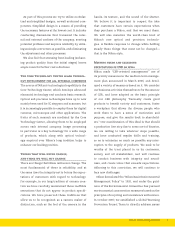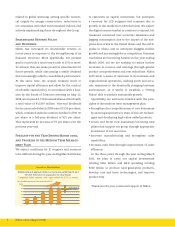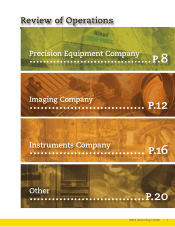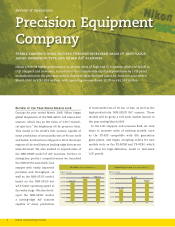Nikon 2008 Annual Report Download - page 17
Download and view the complete annual report
Please find page 17 of the 2008 Nikon annual report below. You can navigate through the pages in the report by either clicking on the pages listed below, or by using the keyword search tool below to find specific information within the annual report.
MAKOTO KIMURA
Director, Member of the Board &
Senior Executive Offi cer
President of Imaging Company
STRENGTHS
IMAGING PRODUCTS SEGMENT ANALYSIS
The main strengths of the Imaging Company are optical
technologies, best represented by the high-quality lenses
forged in history and backed by tradition; expertise in
camera development; image processing technology; and
employees with an intimate knowledge of all things related
to cameras. Nikon draws on these strengths to create prod-
ucts that provide a kind of “camera-ness,” that ineffable
feeling—distinct from the technological capabilities and
advanced feature—that users sense when holding a Nikon.
OPPORTUNITIES
The market for digital SLR cameras during the year ended
March 2008 reached the same level as the peak for fi lm
SLR cameras. There is still the potential for further growth
for digital SLR cameras, however, due to the ease of use
afforded by digitalization, diversity in product concepts,
and growth in emerging markets. Film cameras functions
were limited to picture-shooting, but the shift to digital has
broadened the fi eld for development to post-photography
image processing and viewing. This allows for camera
concepts with greater appeal and a broader range of func-
tions. New products are also constantly being introduced
due to the acceleration of technological innovation inher-
ent in digital products, signifi cantly shortening the product
replacement cycle compared to fi lm SLR cameras.
Moreover, during the market peak for fi lm SLR cameras
most sales were in developed countries. Sales regions will
widen considerably with the growth in markets following
economic development in emerging countries.
CHALLENGES
Nikon had a 40% share worldwide of shipments of digital
SLR cameras during the year ended March 2008, while the
growth rate for shipments of compact digital cameras and
interchangeable lenses exceeded the market average.
However, we are not content with this short-term success.
Market share is just one part of our goal, and there is still
ample room for improvement in sales, profi tability and
other performance factors. We are seeking to advance to
the next level, establishing a corporate culture that consis-
tently takes on new challenges and produces products that
exceed market expectations.
Nikon Annual Report 2008 15
























